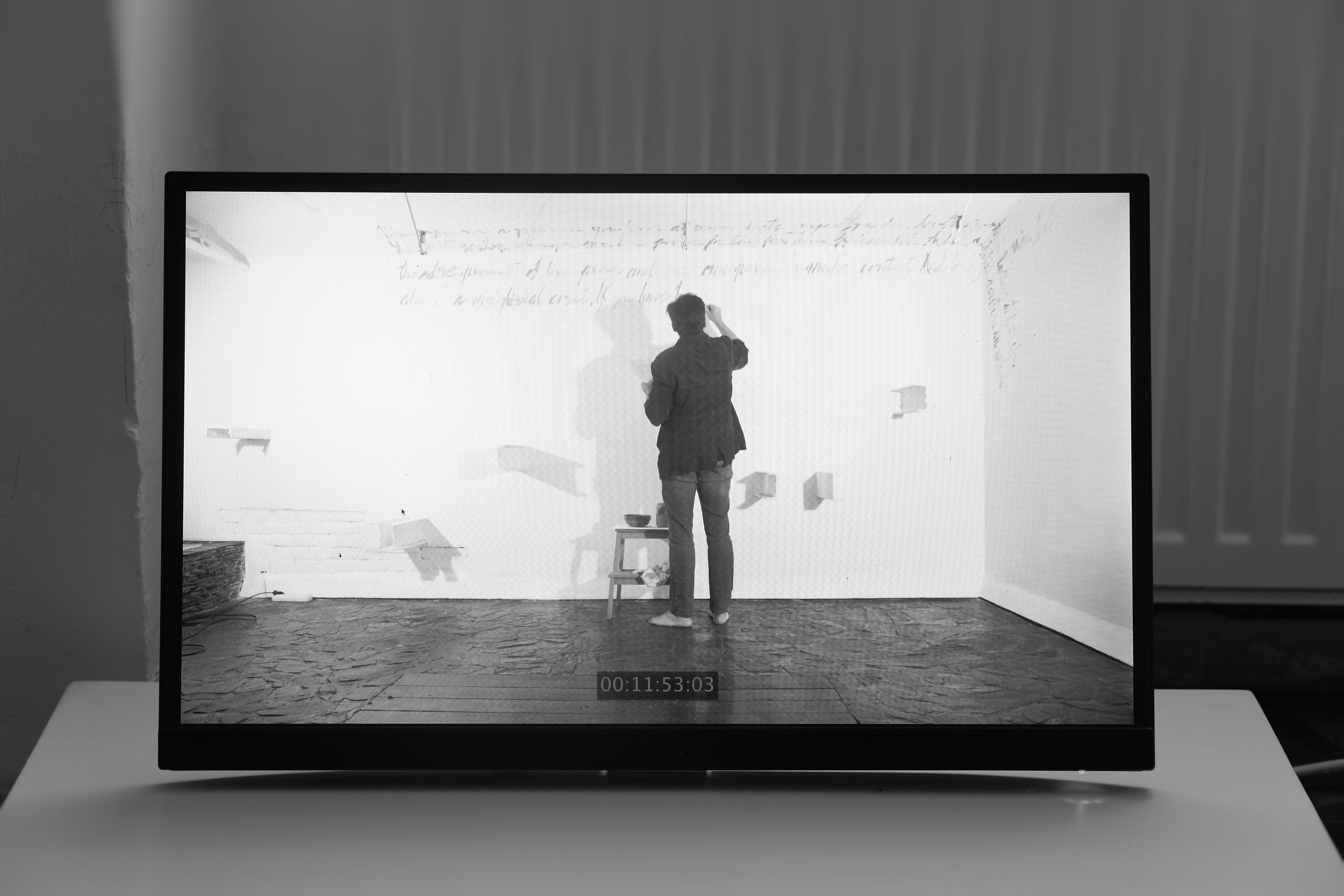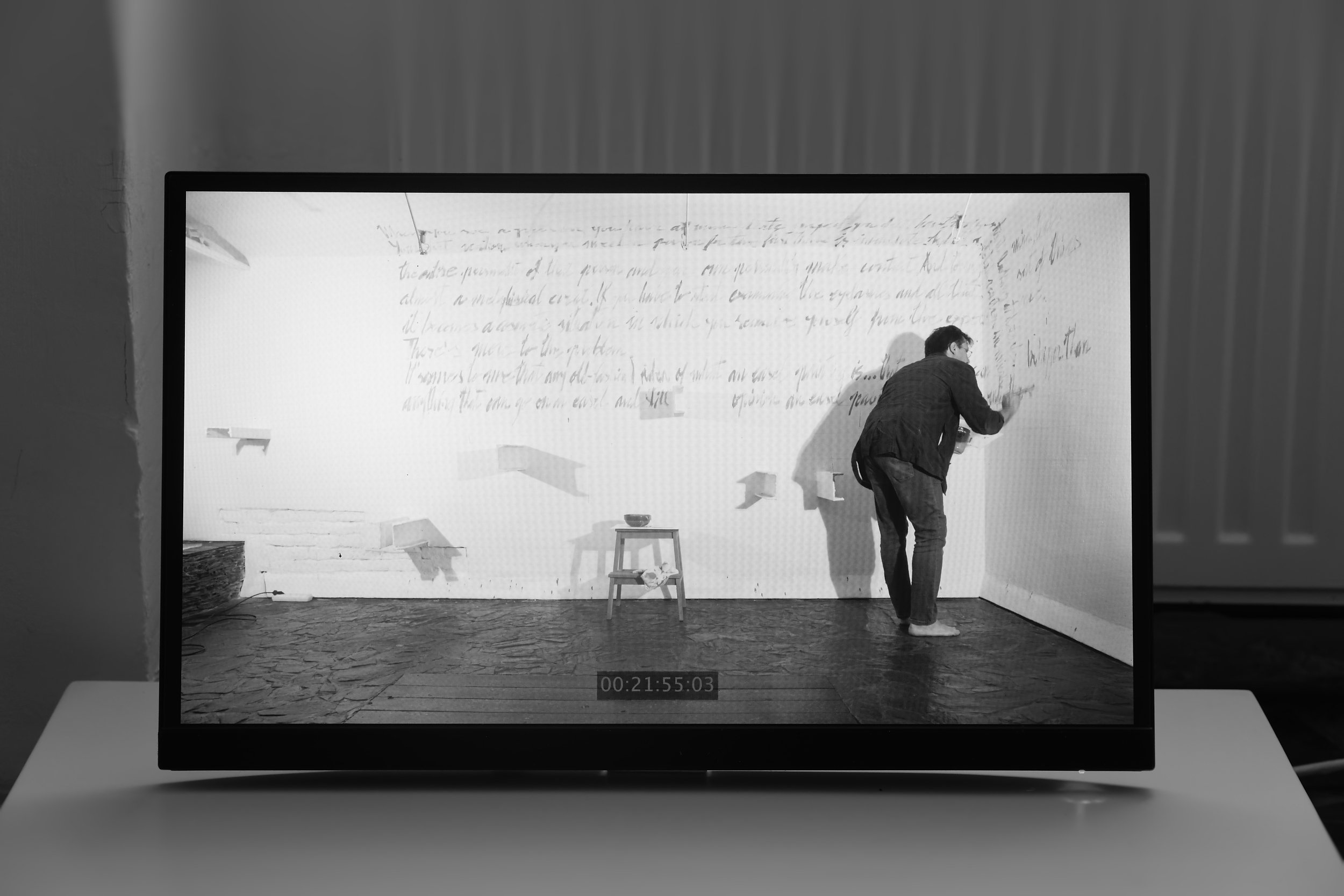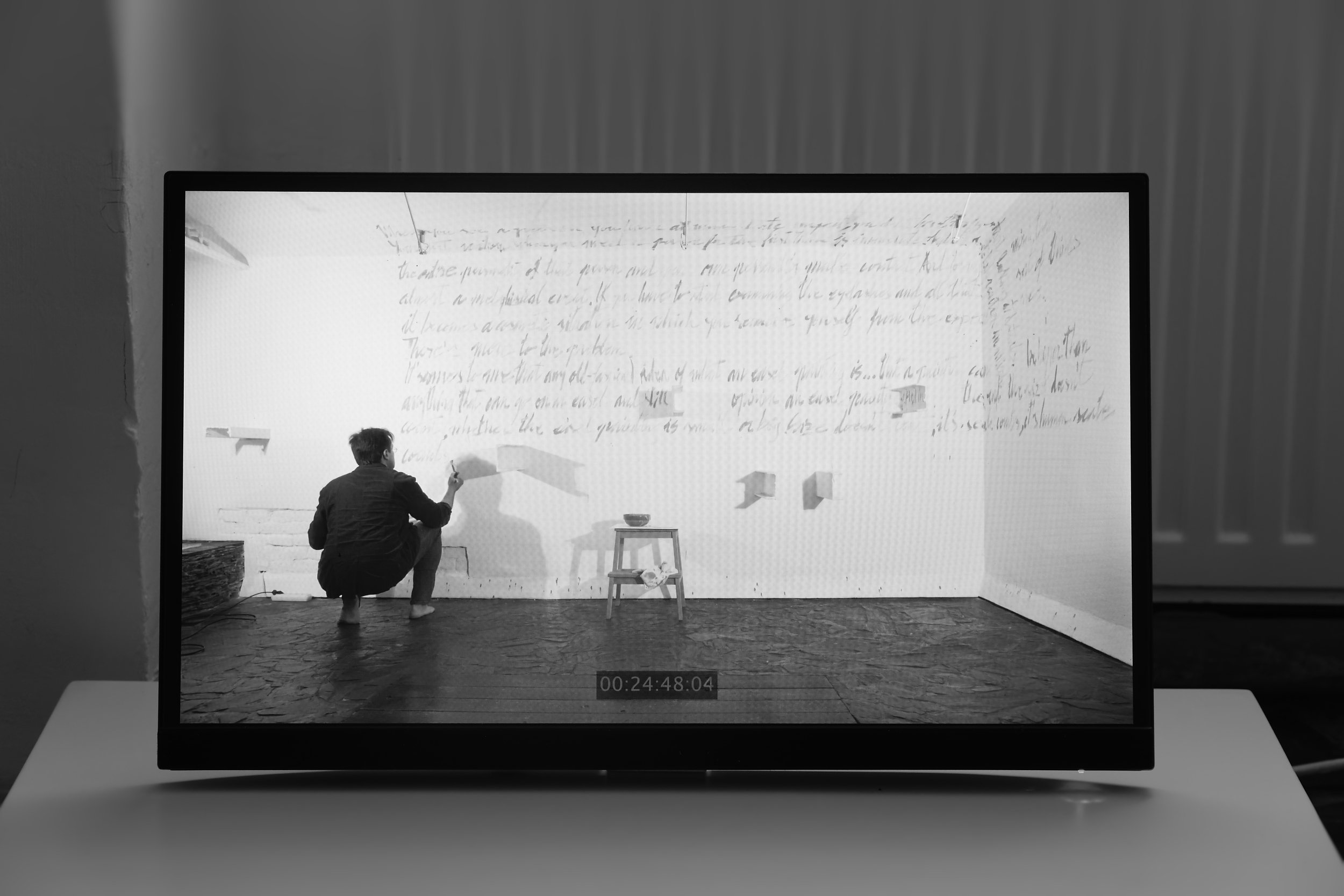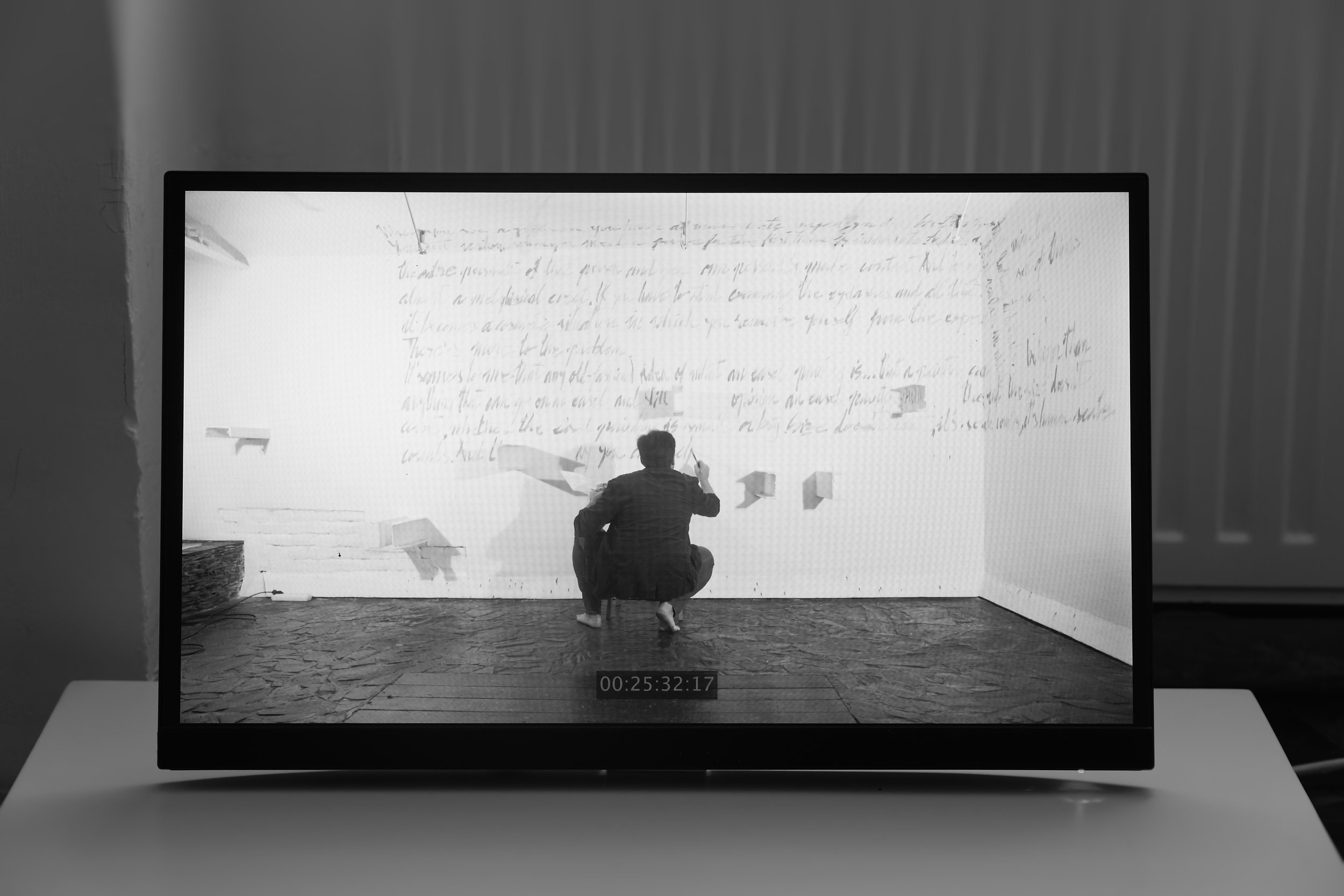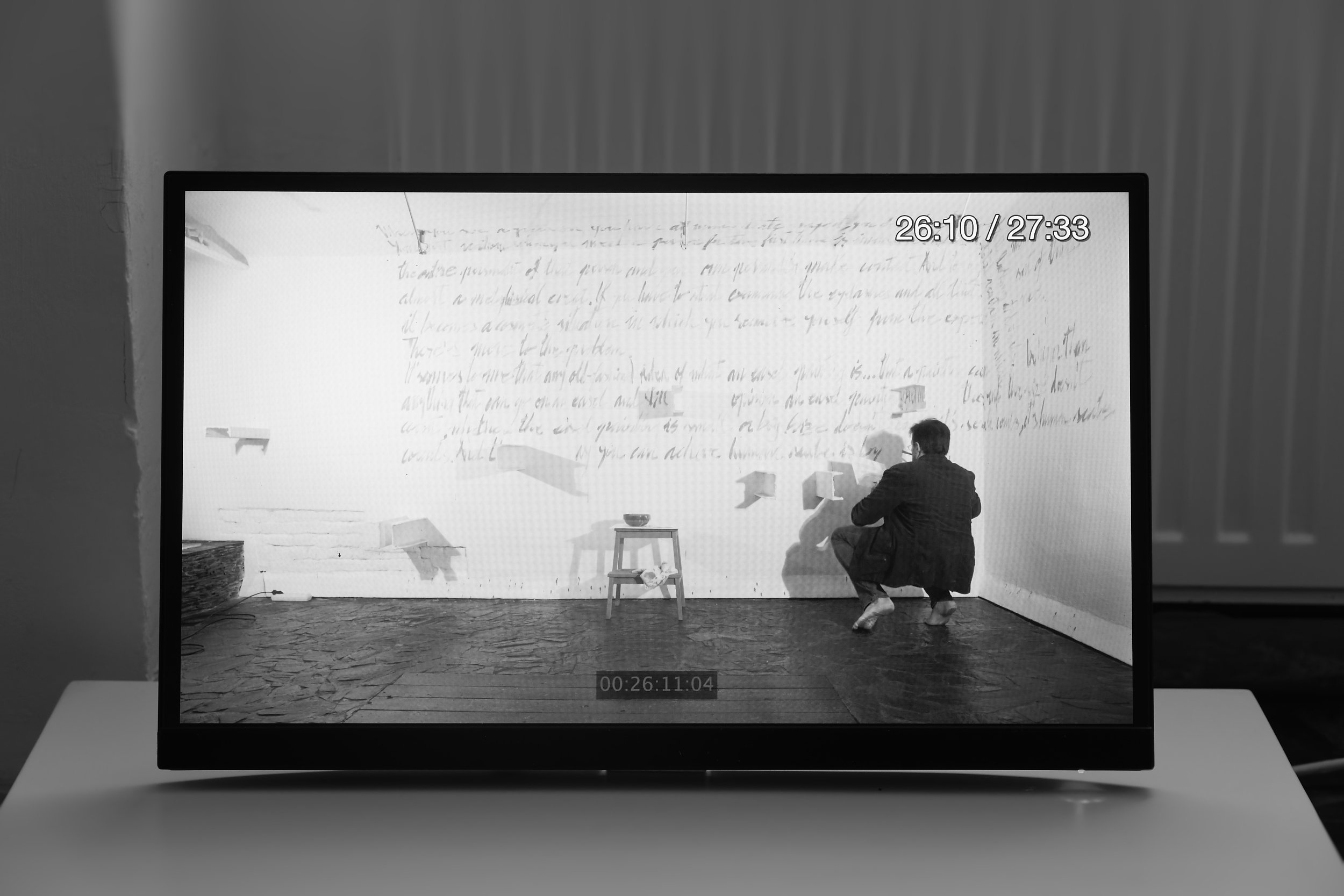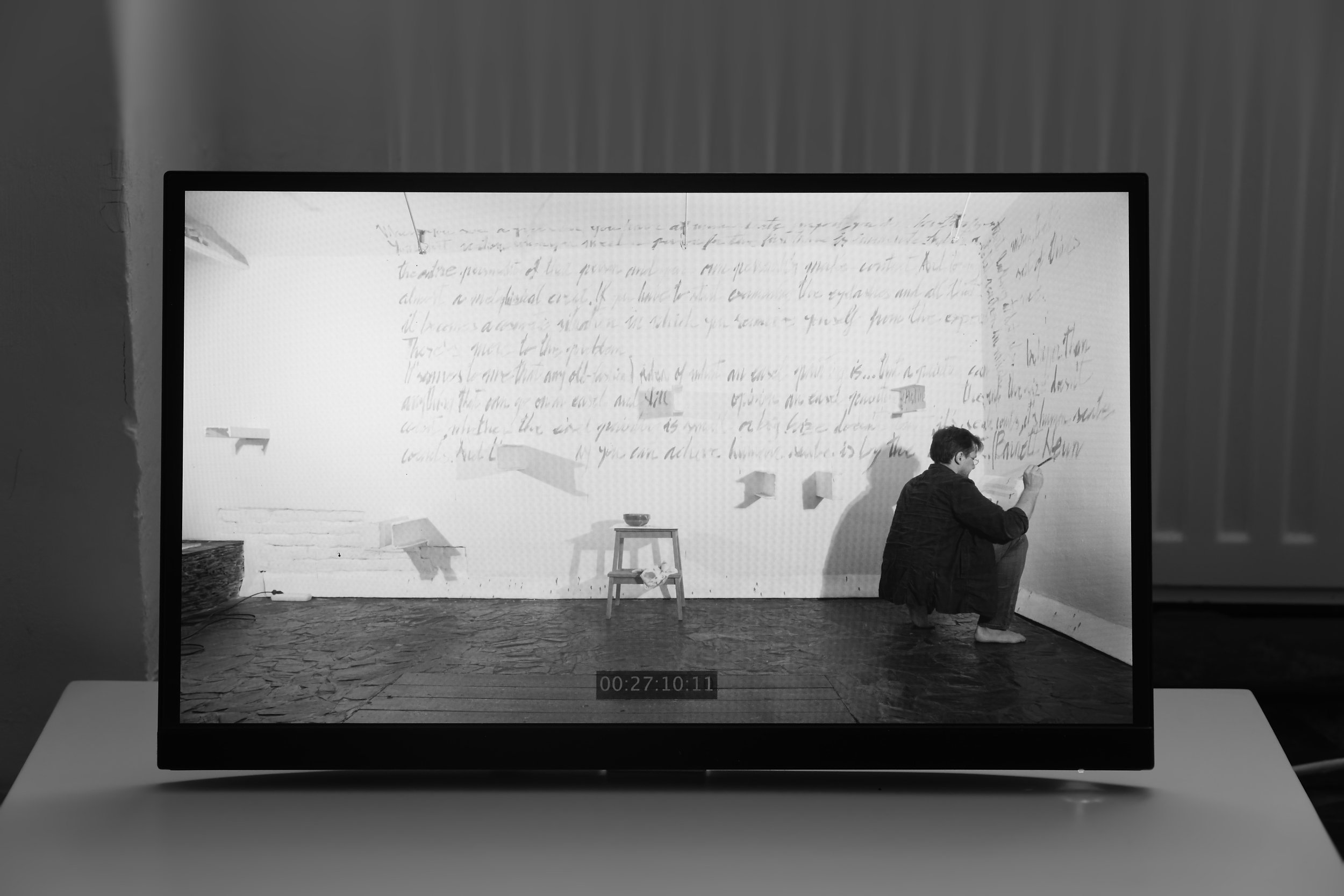Newman, B. | solo show | Galleria 28 Timișoara, 10-25 nov. 2022
-
In the Fall of 2019, I received the proposal to be part of an art fair exhibition in dialogue with an artist who approaches painting working in situ. Each of us had to work on a wall 7 m long and 3 m high. My first thought was to copy/enlarge two pages of a studio notebook by painting them. My studio notebooks are a mystery to me. I don't understand much of what goes on there. They are full of strange, meaningless, and repetitive drawings. They are neither the skeleton nor the indications of an artistic strategy and do not represent thoughts born of intellectual concerns. They are somewhat mysterious presences, sometimes silly, abrupt notes from someone walking in circles, not understanding what is happening to him. There are things that I instinctively avoid showing. But that's precisely why, against instinct, I thought of using them.
In some of these notebooks, I also find texts. Sometimes written by me, sometimes texts I transcribe from interviews with artists I follow. While looking for pages for the proposed project, I realized that two paragraphs from an interview with Barnett Newman were more suitable than any drawing. There are not many filmed interviews with him. I liked it so much that, around 2017-2018, I transcribed it in full. The idea of copying / faithfully enlarging drawings from notebook pages on the white wall has now turned into transcribing text on the wall.
Incidentally, I generally have a problem with text dropped into a painting. Often it functions as an interference; it sends the viewer to a precise place, to the word's meaning. And the painting, constrained, unconvincingly goes that way, too. The techniques of the two languages - writing and painting - are too different, and overlapping, they quickly enter into conflict or redundancy. Anyway, I am not radical. Very successful artists have used text in their paintings, and in some cases, I could be contradicted. However, my mission seemed simple: writing a text on the wall. The initial focus on reproduction/copying now shifts to the proper relation of gesture with context (text on the wall). Lawrence Weiner is an example of an artist who brilliantly uses text. He is clear and precise like a surgeon: font, print, plotter-cutter, and installation team.
I nevertheless need to do things with my own hands. These are B. Newman’s words, which I only select and borrow, but when I write them, they become to a certain extent mine, too. For a performative situation, I had to establish some coordinates and a direction for my approach: a text written relatively quickly with a brush, as if by dictation, respecting rules borrowed from calligraphy, which in current writing I never take into account. Necessary here are the pagination, the height of the lines, the ratio between the brush's thickness and the character's size, and, not least, the emphasis on the line's path from top to bottom. To prepare myself, I made various small sketches on paper, then on a larger scale.
Due to the pandemic, the exhibition was canceled. Locked in the house or the workshop, I kept thinking about it, forced to test what I already knew: the text and the painting together are a complicated thing. I’ve painted an oil surface measuring 1.46 x 2.5 m. I mostly used the wall strategy: calligraphic intention. However, the text is now set against a cool grey background, not a neutral white. Then, while the text was still wet, I painted blue monochrome around it, paying attention to the empty and full relationship between the subject and background.
-
În toamna lui 2019 am primit propunerea de a face la un târg de artă o expoziție în dialog cu o artistă care abordează pictura lucrând in situ. Fiecare trebuia să intervenim pe câte un zid lung de 7 m și înalt de 3. Primul meu gând a fost să copiez/măresc două pagini de caiet de atelier, pictându-le. Caietele mele de atelier sînt un mister. Nu înțeleg mult din ce se întâmplă în ele. Mi se pare că sînt pline de desene fară noimă, repetitive și stranii. Ele nu sînt scheletul sau indicațiile unei strategii artistice. Nu reprezintă gânduri născute din preocupări intelectuale. Sînt mai degrabă prezențe misterioase, uneori puerile, însemnări abrupte ale cuiva care se învârte în cerc, neînțelegând ce se întâmplă de fapt cu el. Sînt lucruri pe care instinctual mă feresc să le arăt. Dar tocmai de aceea, contrar instinctului, m-am gândit să le folosesc.
În unele dintre aceste caiete, găsesc și texte. Uneori scrise de mine, alteori texte pe care le transcriu din interviuri cu artiști pe care îi urmăresc. Căutând pagini potrivite pentru proiectul propus, mi-am dat seama, de fapt, că mai potrivit decât orice desen, ar fi două paragrafe dintr-un interviu cu Barnett Newman. Interviuri filmate cu el, sînt puține. Cel pe care l-am găsit, probabil prin 2017-2018, mi-a plăcut atât de mult încât l-am transcris în totalitate. Ideea de a copia / de a mări fidel pe un zid alb desene din pagini de caiet, s-a transformat acum în a transcrie un text pe perete.
Ca o paranteză, trebuie să spun că am în general o problemă cu textul-aruncat-în-pictură. De multe ori el funcționează ca un bruiaj, trimite privitorul de imagine undeva precis, către sensul cuvântului. Iar pictura, constrânsă, o ia neconvingător într-acolo. Tehnicile celor două limbaje - scrisul și pictura - sînt prea diferite pentru ca, suprapuse, să nu intre repede în conflict sau redundanță. În fine, nu sînt radical, există artiști de mare succes care au folosit textul în pictură. În unele cazuri, ceea ce cred eu aici e probabil contrazis. Pentru mine însă, misiunea părea simplă: să scriu un text pe perete. Accentul care inițial era pe reproducere / copiere se mută acum pe adecvarea gestului la mediu (text pe perete). Lawrence Weiner e un exemplu de artist care folosește briliant textul. E limpede și precis ca un chirurg: font, print, plotter-cutter, echipă de montaj.
Eu am însă nevoie să fac lucrurile cu mâna mea. Sînt vorbele lui B. Newman, pe care eu doar le selectez, le împrumut, iar scriindu-le, le fac un pic și ale mele. Pentru un gest performativ, trebuia să îmi stabilesc niște coordonate, o direcție de lucru: un text scris relativ repede cu pensula, ca după dictare, respectând reguli împrumutate din caligrafie, de care în scrierea curentă nu țin seama nicodată. Sînt importante aici paginarea, înălțimea rândurilor, raportul între grosimea pensulei și dimensiunea caracterului, accentul pe traseul liniei de sus în jos. Pentru a mă pregăti, am făcut diverse schițe pe hârtie iar mai apoi, la scară naturală.
Din cauza pandemiei, expoziția nu a mai avut loc. Iar eu, închis în casă sau în atelier, am rămas cu gândul la ea, nevoit să testez ceea ce, am hotărat deja, e un lucru complicat: textul și pictura. Am pictat în ulei o suprafață de 1,46 x 2,5 m. În mare parte am folosit strategia pentru perete: intenția caligrafică. Textul este însă pictat acum pe un fundal rece-gri-colorat, nu pe un albul neutru al peretelui. Apoi, când textul era încă ud, am pictat monocrom în jurul lui, atent fiind la relația gol-plin, dintre subiect și fundal.












